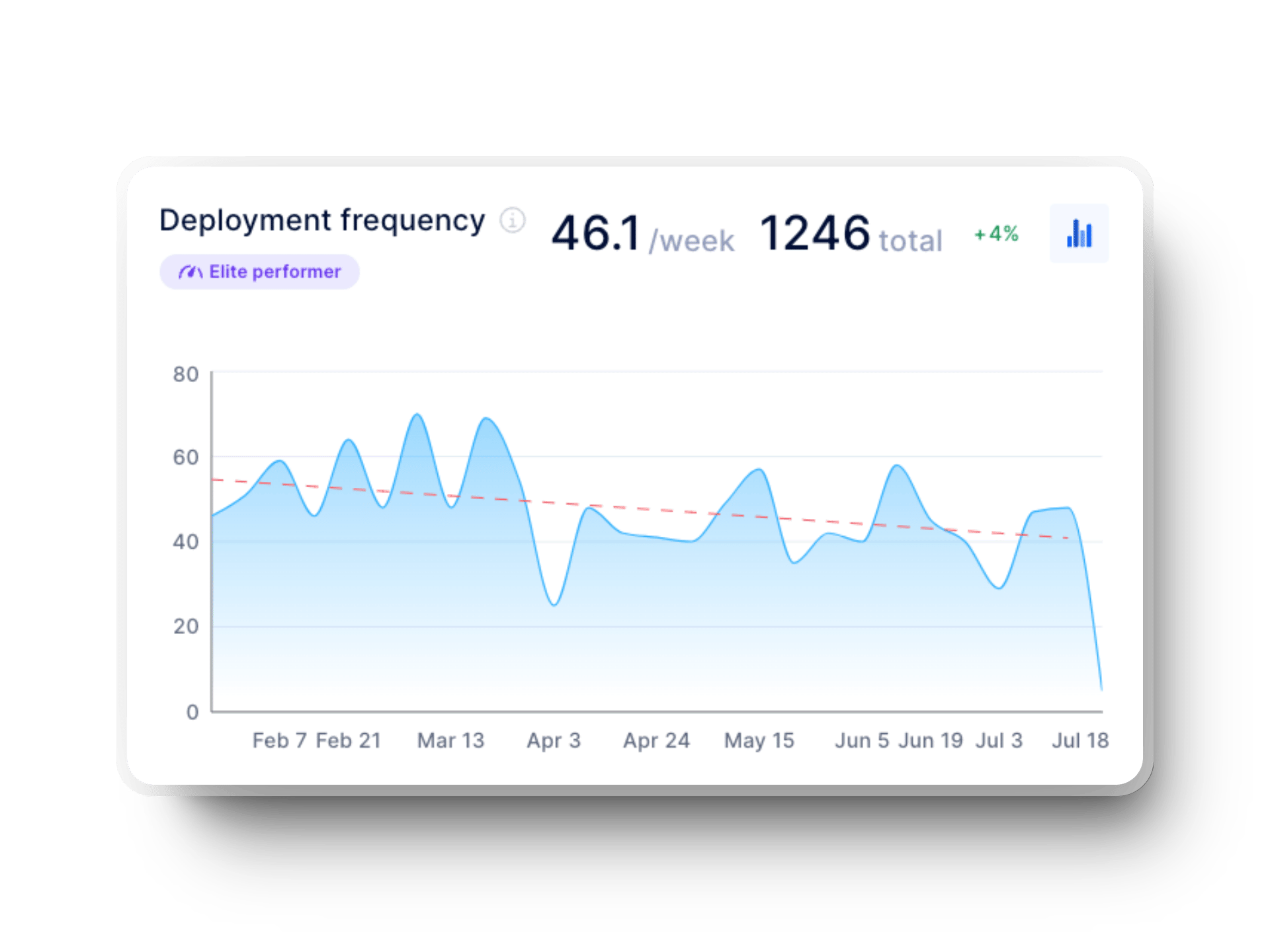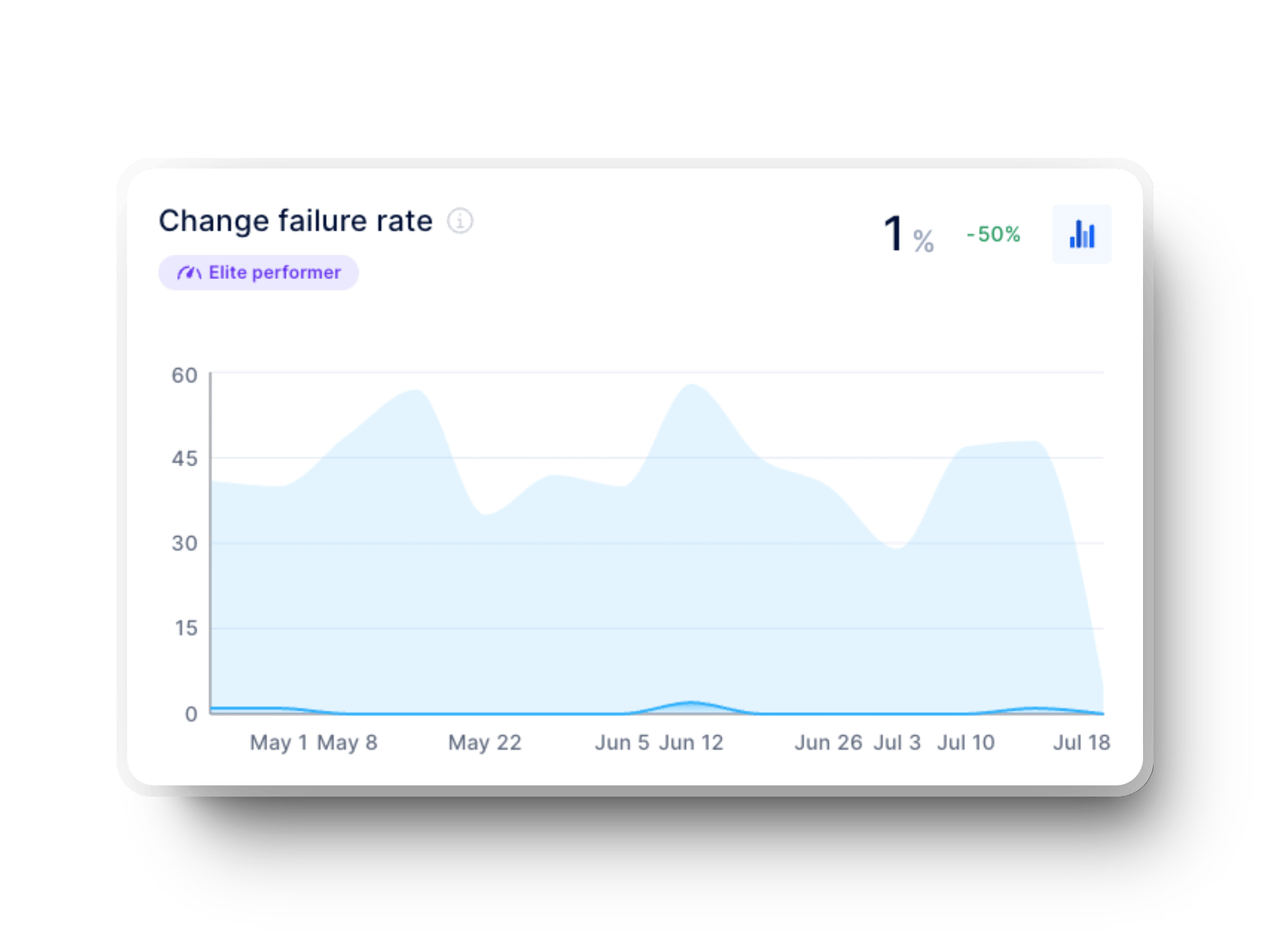The DevOps maturity model is not just a buzzword. This is a roadmap that your organization can use to adopt and optimize your DevOps practices progressively.
It basically guides your teams through various stages of growth, from basic automation and collaboration to full integration of advanced DevOps strategies.
If you strive for continuous improvement, the model will give you a clear path for optimizing operations teams and the development pipeline.
Adopting DevOps principles lets you streamline workflows, boost team productivity, and better align with business objectives.
Let’s see exactly how you can do that.
Insider tip: The Axify dashboard allows you to track your team’s performance at each stage of the DevOps maturity journey. Axify gives you real-time feedback through DORA, Agile, and flow metrics in one place to smoothen this transition for the entire team.
What Is the DevOps Maturity Model?
The DevOps maturity model is a structured framework that helps you:
- Assess your current maturity levels in DevOps practices.
- Map out a path to progress.
That way, you can systematically shift from traditional, siloed IT operations to a more collaborative and automated environment, aligning development and operations teams.
Remember: The model’s arguably main advantage is that it encourages continuous learning and improvement. Your teams can build on their capabilities over time and achieve a competitive edge.
Besides, integrating advanced DevOps principles allows you to increase deployment frequency, improve software quality, and streamline the entire software development process.
Insider tip: Use Axify’s DORA metrics to track the success of your DevOps initiatives. Leverage key insights into deployment frequency, lead time for changes, change failure rate, and time to restore service to focus on what matters most—consistent improvement and optimal performance.
Benefits of Achieving DevOps Maturity
One of our clients, Business Development Bank of Canada, achieved impressive results by optimizing its software delivery processes in three months. Using Axify led to a 51% faster delivery time and reduced time in pre-development by up to 74% and QA by up to 81%. BDC also saw a 24% increase in capacity and an annual recurring productivity gain of $700,000.
The main driver behind this result was striving for continuous improvement using DORA metrics and Value Stream Mapping.
.png?width=1318&height=1050&name=DORA%20(1).png)
You can get similar results once you reach DevOps maturity. Let’s break down the benefits.
Faster Adaptability
Achieving DevOps maturity gives you the flexibility to respond quickly to changing market demands. With streamlined DevOps practices, you can quickly adapt your development processes and adjust to new business goals to stay ahead of the competition.
Opportunity Tapping
As your DevOps processes mature, the ability to rapidly deploy new features and services becomes second nature. With continuous delivery and a more efficient deployment process, you can seize opportunities faster, bringing innovations to your customers and increasing your ability to deliver business value.
Improved Scalability
A mature DevOps approach ensures smooth and efficient application and infrastructure scaling. Automating manual processes and improving configuration management help you handle increasing demands without compromising performance, ensuring your systems are ready for growth.
Operational Efficiency
Streamlined workflows and reduced costs are direct benefits of achieving higher maturity levels in DevOps. Automation and well-structured processes help your team minimize inefficiencies, improve collaboration, and enhance operational efficiency.
Increased Delivery Speeds
Mature DevOps practices entail continuous integration and improved delivery pipelines. One advantage is that you’ll have faster, more reliable code deployments, reducing your time-to-market for new features. As you release updates quickly and confidently, your users stay happy, and your business moves forward.
Insider tip: Use Axify Software Delivery Forecasting to optimize your software deliveries and meet your goals.
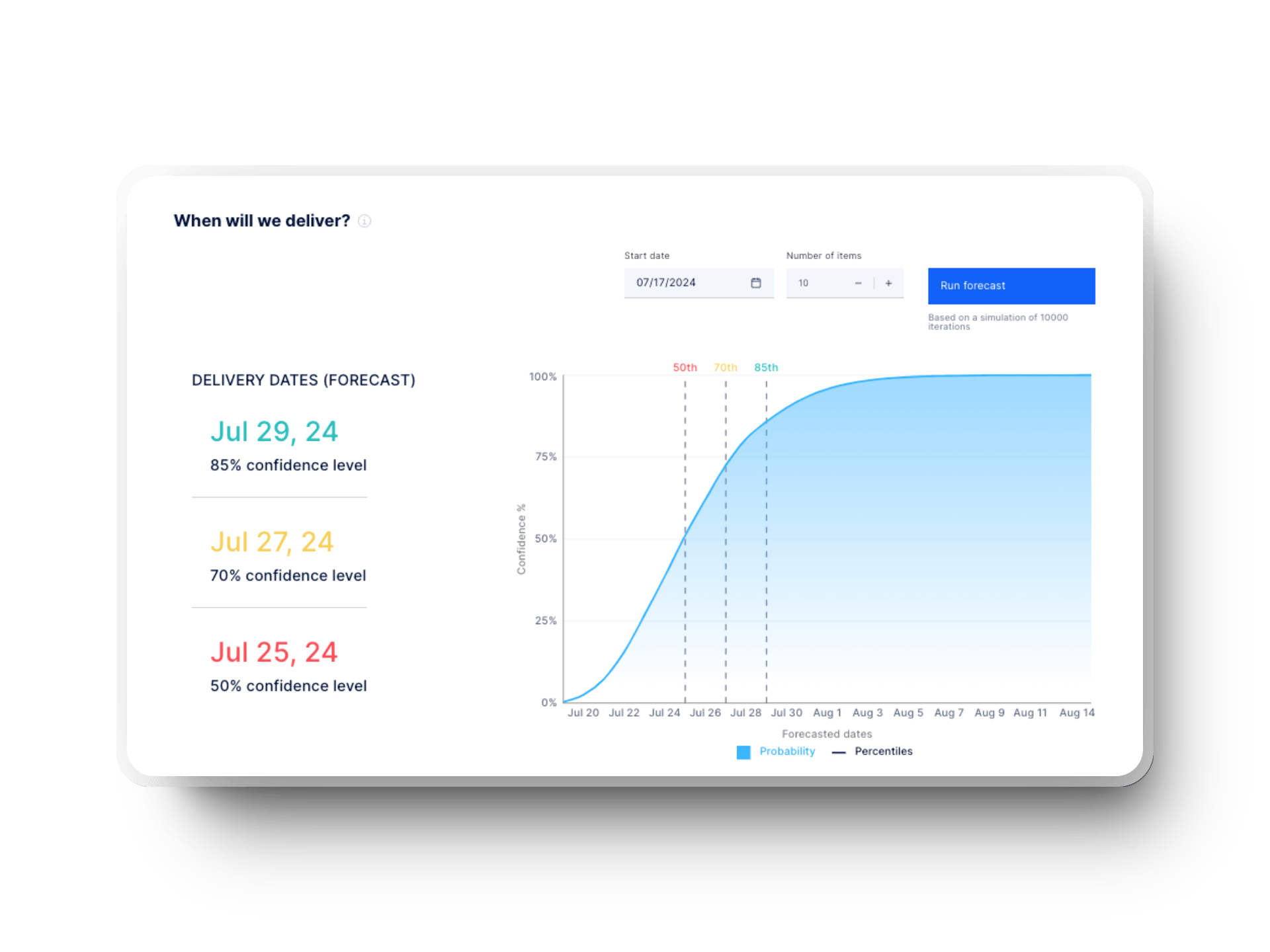
Enhanced Quality
Reaching higher levels of DevOps maturity naturally leads to better software quality and a more seamless user experience. After all, you’ll integrate more code quality checks and automated security scans into your pipeline. That way, you can catch issues early and make sure your product meets high-quality standards every time.
What Are the Stages of DevOps Maturity?
DevOps maturity has five stages: initial, managed, defined, measured, and optimized. Each stage has a key focus and challenges that prevent you from reaching those goals.
Insider tip: Axify’s Maturity Assessment tool helps you understand your current DevOps maturity level and offers personalized tips to move to the next stage.

Stage 1: Initial DevOps Maturity Stage
At this stage, you’re most likely operating in a traditional IT environment, where siloed teams work independently, and there’s minimal automation. Collaboration between operations and development teams is rare, and processes are manual and inefficient. This results in slow delivery cycles, high failure rates, and a lack of agility when responding to changes.
However, you may rely on legacy systems and need help adapting to modern DevOps practices.
- Key focus: Moving away from manual processes and encouraging a culture of collaboration to begin breaking down silos.
- Challenge: The lack of communication and automation increases the risk of security breaches and slows development.
Stage 2: Managed DevOps Maturity Stage
You introduce basic DevOps practices in this stage, focusing on initial automation and continuous integration. Teams start collaborating more effectively, with some cross-functional teams forming, but processes must be fully standardized. The goal is to establish agility and implement automation in repetitive tasks like testing and deployment.
- Key focus: Implementing configuration management and automating simple, repetitive tasks to speed up development.
- Challenge: Ensuring alignment across teams while managing the transition from traditional methods to more agile workflows.
Stage 3: Defined DevOps Maturity Stage
By this point, your organization has achieved organization-wide adoption of DevOps. There are now defined processes for development and deployment, and continuous delivery is becoming the standard. Automation tools are used across the software development process, and DevOps capabilities are embedded into your teams' operations. Collaboration is no longer an exception but the norm, and your DevOps strategy is clearly outlined.
- Key focus: Establishing continuous deployment pipelines and improving software quality through SDLC best practices.
Stage 4: Measured DevOps Maturity Stage
In the measured stage, you begin to actively monitor and measure the success of your DevOps processes using key performance indicators (KPIs). You track Agile metrics to ensure ongoing continuous improvement. With data-driven insights, you can spot inefficiencies, bottlenecks, and areas that need improvement.
- Key focus: Using metrics and KPIs to identify improvement opportunities and streamline processes.
- Challenge: Ensuring that teams collect data and use it to optimize the delivery process continuously.
Insider tip: Use the Axify Value Stream Mapping Tool to get a bird’s eye view of your operations and value creation throughout the development cycle. It will help you highlight inefficiencies, correct course, and reduce cycle times.

Stage 5: Optimized DevOps Maturity Stage
DevOps is fully integrated into your organization’s culture at this final stage. You’ve achieved operational efficiency with a focus on continuous innovation. Automation is deeply embedded, and your team is empowered to experiment and scale as needed. Collaboration across the organization is seamless, and you’ve built a high-performing DevOps team that can handle both small and large-scale deployments effortlessly.
- Key focus: Nurturing a DevOps culture that prioritizes scalability and innovation while continuing to reduce the risk of security breaches.
- Challenge: Maintaining continuous improvement momentum and avoiding stagnation as you scale and grow.
Insider tip: Axify integrates with several Agile tools that support your company’s growth. Aggregating all this data in one unified dashboard helps you stay on top of key metrics that measure your progress. Besides, your entire team has access to this unified information. The result is better collaboration and streamlined work to a common goal.
What to Focus on to Achieve DevOps Maturity
If you want to transition smoothly through all the DevOps maturity stages above, focus on the following issues.
Culture and Strategy
Building a strong DevOps culture of collaboration is arguably the most essential mindset change, but the results are worth it. A collaborative culture leads to quicker problem-solving and more innovative solutions. To achieve that:
- Encourage transparency, regular communication, and cross-functional teams that align with your business objectives.
- To align your DevOps strategy, set clear goals that reflect the company’s long-term vision while promoting continuous learning and adaptability.
- Start by holding regular meetings where teams can discuss roadblocks, share feedback, and set joint objectives.
Insider tip: Axify’s Team Well-Being Tracker helps you monitor your teams' feelings, ensuring that collaboration remains positive and efficient throughout the DevOps maturity journey.
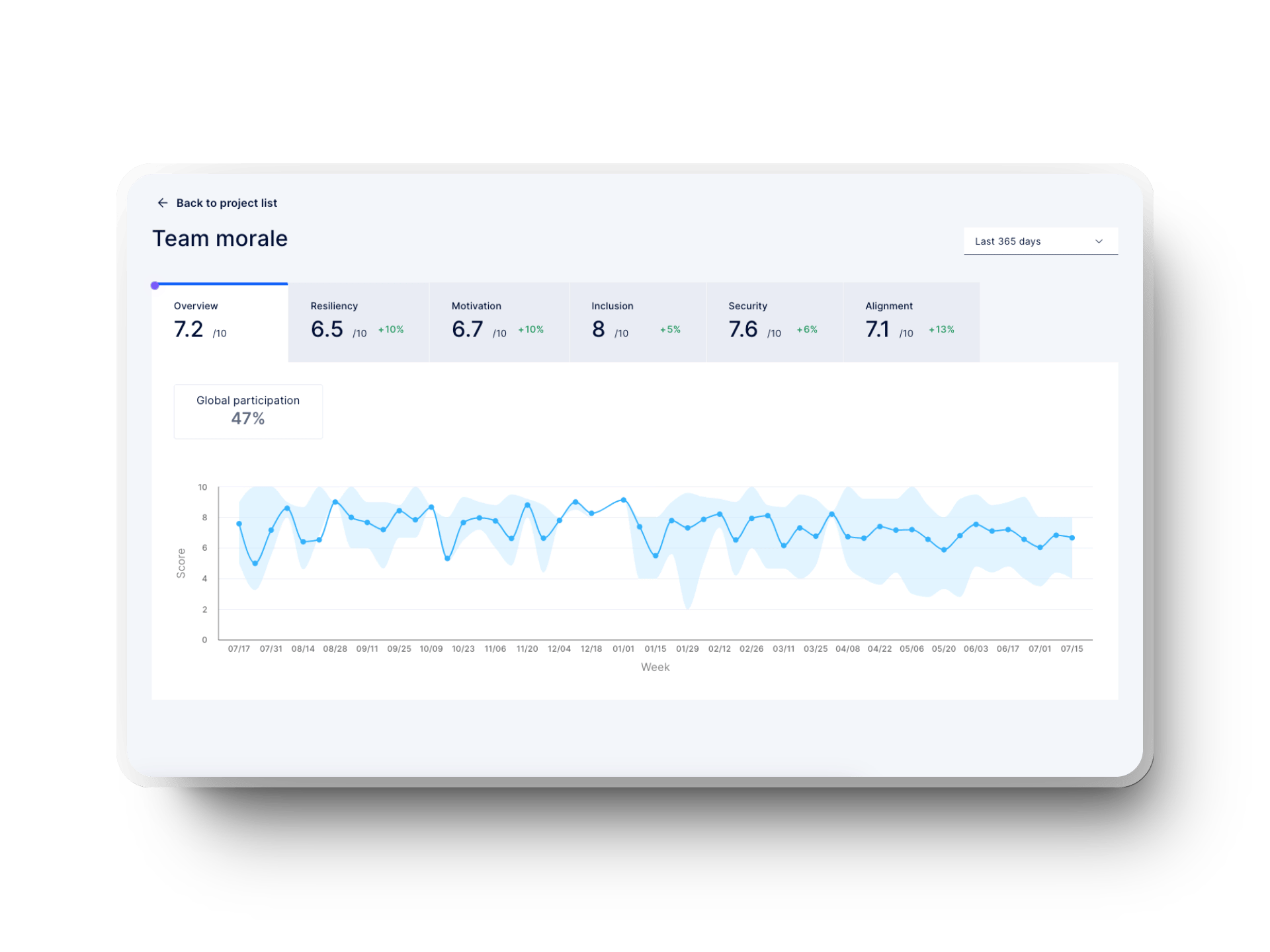
Automation
Automating repetitive tasks is a core part of achieving DevOps maturity because it improves operational efficiency and reduces human error. Automation also frees your team to focus on more value-added work, improving overall productivity.
Here’s what we advise:
Focus on automating tasks like continuous integration, testing, code review, and deployment. Automate security checks and configuration management to ensure that your processes are consistent, scalable, and easier to manage.
Pro tip: Implement version control systems to automate code management and continuous deployment pipelines to streamline releases.
Structure and Process
Structured processes help scale your DevOps efforts. Well-defined workflows ensure that everyone follows DevOps practices consistently across all stages of the software development lifecycle.
Make sure you establish process improvements that are constantly evolving based on feedback and metrics. This structured approach should cover everything from deployment pipelines to incident management, ensuring smooth and reliable software releases.
Pro tip: Develop a roadmap for organizations with a detailed DevOps strategy. Ensure your processes are flexible enough to adapt to changing business goals but structured enough to maintain high-performance standards.
Collaboration and Sharing
One of the most critical aspects of DevOps maturity is the ability to foster collaboration across teams. It’s important to create a common language between developers, operations, and business stakeholders and ensure that all parties are involved in key decisions around software delivery.
Sharing knowledge and insights is essential because it helps teams stay aligned and work toward a common goal. This collaboration improves team morale and the overall performance of your DevOps environment.
Insider tip: Use tools that promote visibility and open communication. For example, set up feedback loops that allow teams to share insights and improvements continuously. Establish shared dashboards that provide a unified view of progress and goals. Use the Axify Executive Dashboard to see real-time updates and data, fostering transparency and keeping teams aligned on daily priorities.

How to Measure DevOps Maturity
Measuring DevOps maturity involves tracking key performance indicators that show whether your DevOps practices are functioning well. These metrics help you understand where your team stands and identify areas for improvement.
Let’s examine some of the most important metrics for assessing DevOps maturity.
Deployment Frequency
Deployment frequency measures how often your team successfully deploys code to production. High-performing teams deploy small, frequent updates rather than large, infrequent releases. Frequent code deployments reduce risk by minimizing the size of each change, allowing for faster fixes when issues arise.
Example: If your team deploys 10 times daily but struggles with post-deployment issues, this is an opportunity to refine automation and testing processes to ensure smoother releases.
Failed Deployment Recovery Time
The DORA metric Mean Time to Recovery (MTTR) has changed its name to Time to Restore Service and, more recently, to Failed Deployment Recovery Time. Regardless of how you refer to it, this KPI measures how quickly your team can recover from a failure. A lower recovery time indicates that your team can quickly diagnose and resolve issues, leading to higher customer satisfaction and less disruption.
Tracking this KPI helps improve incident management and your DevOps environments' reliability.
Pro tips:
- Focus on automating your response to incidents with alerting systems that quickly notify the team of issues.
- Develop a clear incident response plan with detailed steps for identifying the root cause and rolling back faulty deployments.
Example: If your failed deployment recovery time is longer than expected, you might identify gaps in your configuration management or slow communication between teams to reduce downtime.
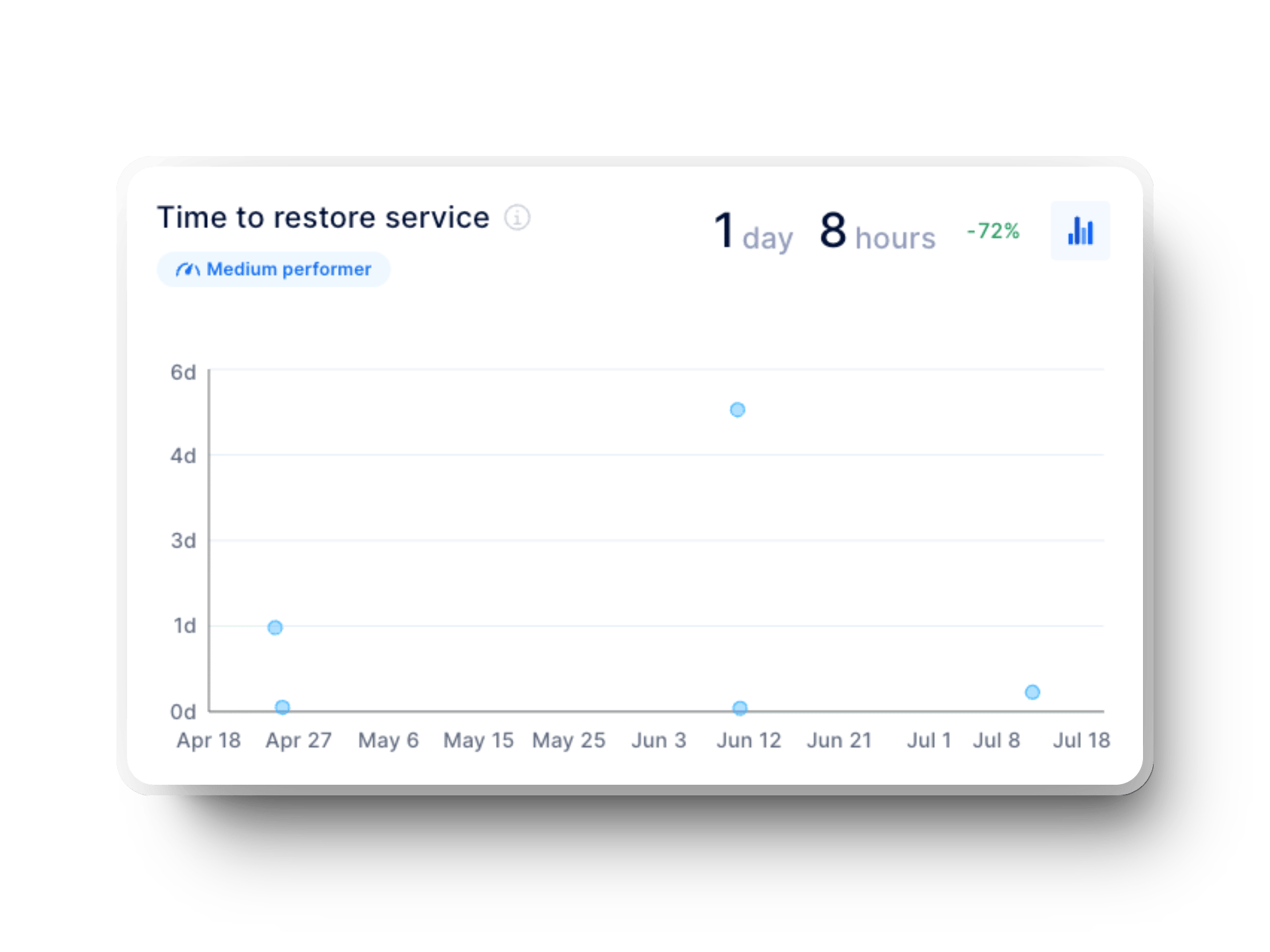
Lead Time for Changes
Lead time for changes measures the average time between the first commit made in the dev environment and when that feature is successfully running. This metric is crucial for understanding the efficiency of your development process. A shorter lead time means faster delivery of new features, bug fixes, and updates.
Pro tips:
- Implement continuous integration to automate code testing and review, reducing the time code waits for approval.
- Focus on optimizing your deployment pipelines to eliminate bottlenecks.
Example: If your lead time is extended, you may have issues with slow testing or manual processes. Automation tools can reduce this time by running tests and code reviews in parallel.

Change Failure Rate
The change failure rate represents the percentage of deployments that result in a failure, such as a bug or outage. A low failure rate indicates high-quality code and reliable processes. Reducing this rate is critical to achieving a mature DevOps environment.
Pro tips:
- Implement automated security checks and code quality checks to catch issues before they reach production.
- Set up continuous monitoring to detect and fix issues as soon as they occur, reducing the impact of failures.
Example: If your change failure rate is high, improve test coverage and automate code reviews to catch bugs early in the pipeline.
DevOps Maturity and Security
As organizations progress through their DevOps maturity journey, security practices become deeply integrated into the software development process, leading to the emergence of DevSecOps.
Security is no longer a last-minute concern but is embedded in every development lifecycle stage. This shift ensures that security is addressed alongside code quality and operational efficiency, reducing the risk of security breaches.
- Continuous monitoring: Mature DevOps environments rely heavily on continuous monitoring to detect and respond to potential vulnerabilities in real-time. With automated tools scanning for security issues, teams can catch threats early before they impact the system.
- Automated compliance checks: Integrate these checks directly into the deployment pipelines. These automated checks ensure that security policies, such as security scans and code quality checks, are followed consistently. This reduces manual effort while ensuring that every change aligns with the company’s corporate policies and security standards.
- DevSecOps and cross-functional teams: Development, operations, and security teams should collaborate closely. This way, you can deliver secure, high-quality software faster. Early-stage (aka shift-left) security checks in the development process reduce vulnerabilities and prevent issues later in the delivery process.
- Operational efficiency and security: As teams progress through higher maturity levels, they optimize their security processes to improve operational efficiency and software quality. Mature DevOps practices, thanks to continuous feedback loops and well-structured frameworks, allow for faster, more frequent deployments without compromising on security.
- Increased resilience: A mature DevOps environment is better equipped to handle security incidents and threats. With automated security measures and incident management tools, mature DevOps teams can recover from security breaches faster and mitigate damage, reducing their overall failure rate and ensuring smoother operations.
Start Your DevOps Maturity Journey with Axify
Our platform has helped numerous organizations implement DevOps best practices. Our BDC case study shows how we support continuous improvement, collaboration, and optimization throughout the software development lifecycle.
Here are some features you can leverage to advance through the various stages of DevOps maturity:
- Development team maturity analysis: Axify offers in-depth DevOps maturity assessments to help you understand your team’s current maturity level. Fill in the quiz, and we’ll gauge your team's performance across key areas. We’ll also give you actionable recommendations and improvement opportunities tailored to your organization’s needs.
- Real-time metrics and forecasting: Axify delivers real-time engineering metrics that provide valuable insights into your team’s performance. We also forecast delivery outcomes and time-to-zero. This info empowers you to make proactive adjustments, reducing the likelihood of delays and ensuring smoother deployments.
- Value Stream Mapping (VSM): Axify visually represents how work flows through your system, helping you spot areas that slow down progress. Use Axify’s VSM to track how long work items spend in different phases of development and streamline workflows to improve overall efficiency.
- Team well-being tracker: Achieving DevOps maturity means ensuring your teams are healthy and sustainable. Use real-time data from the Axify well-being tracker to adjust workloads or team dynamics. This will ensure sustained productivity and reduce burnout.
- DORA metrics tracking: Axify automates the tracking of the essential DORA metrics. You’ll get a clear picture of how your team is performing and quickly identify areas for enhancement.
- Continuous improvement with OKRs: Axify supports teams in setting and tracking Objectives and Key Results (OKRs). For example, you can set OKRs for key DevOps improvements, such as reducing deployment times or improving collaboration between development and operations teams, and use Axify to monitor real-time progress.
As you can see, Axify provides an all-in-one solution for guiding your team through each stage of the DevOps maturity model.
Ready to optimize your DevOps maturity journey?
Book a demo today and see how Axify can help your team take the next step.






.png?width=60&name=About%20Us%20-%20Axify%20(2).png)


